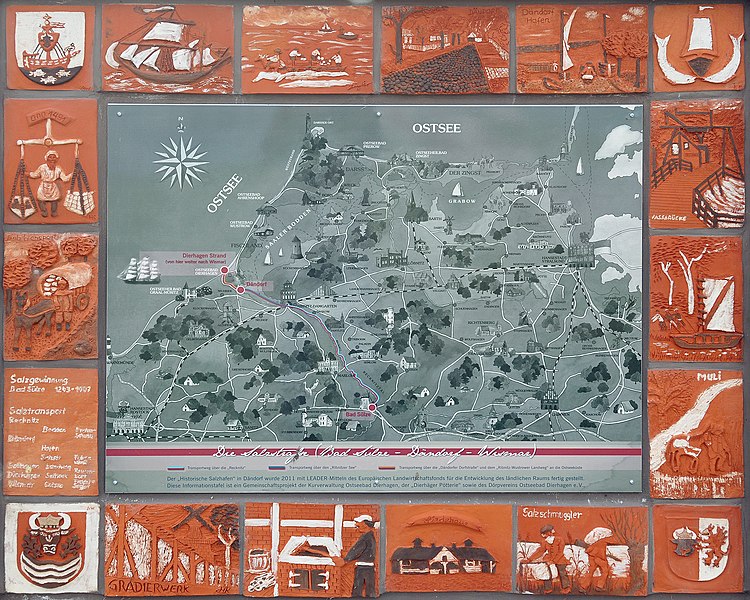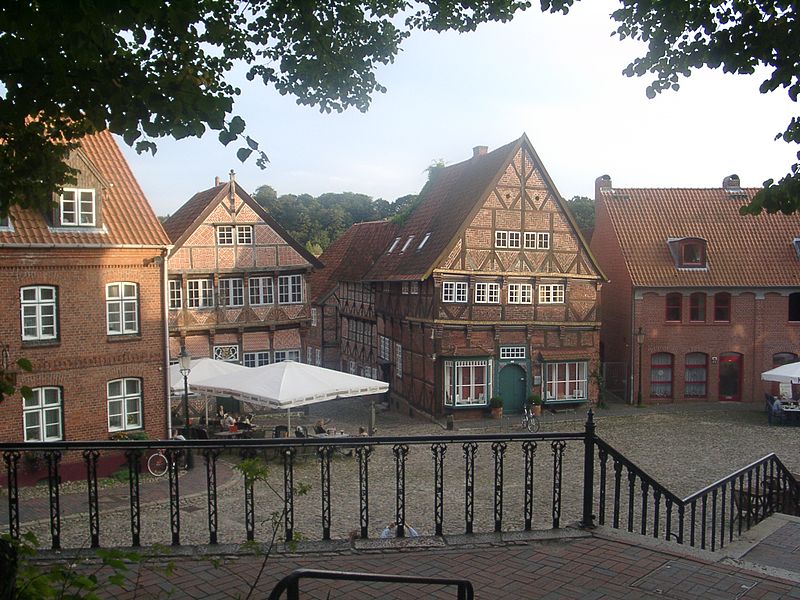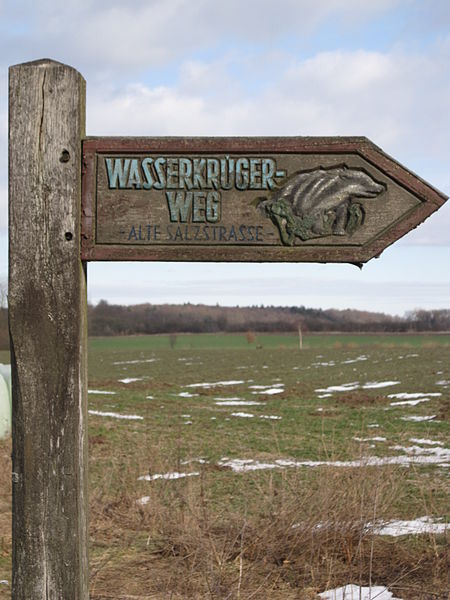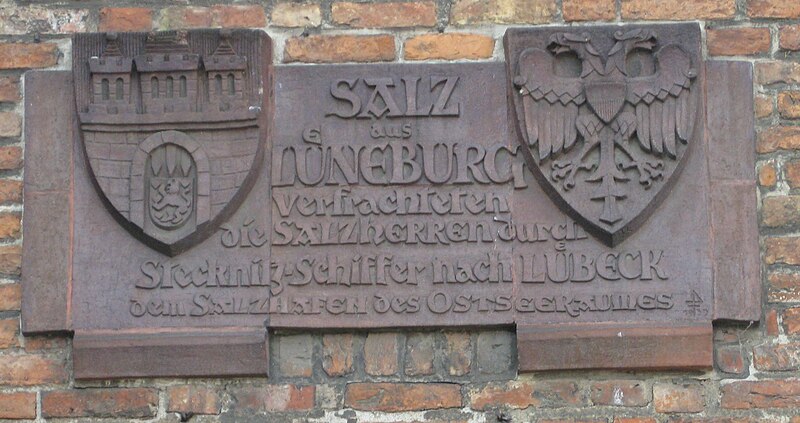Have you ever heard the expression, “Worth your weight in white gold?” If you have, you probably know that it doesn’t refer to rings or riches. Strange as it may seem, “white gold” was once a name for a common mineral most of use on a daily basis: table salt.

Der Lübecker Salzspeicher in heller Erleuchtung, von Andreas Plenz/Saperaud, adapted by Wandering Educators
Table salt is a household staple. Everyone has it, everyone uses it, and most people don’t think twice about it. Salt was not always such an easily accessed resource, however. In the Middle Ages, salt was incredibly important for preserving food and adding flavor to otherwise bland meals. It was as significant to the medieval economy as natural oil and gas are to us now. Due to its limited availability and importance, it earned itself the nickname “white gold.” Extensive trade routes were created to transport it from the old salt town of Lüneberg to the Baltic Sea, where tons of salt were shipped around the Baltic States and Scandinavia. There, the salt was used to preserve large numbers of fish, a staple of the medieval diet.

The salt route from Bad Sülze on Dändorf to Wismar in the years 1243-1907. Wikimedia Commons: Michael Gäbler
Back in the day, it was an over 20 day journey by wagon from Lüneberg to Lübeck on the Baltic Sea. Happily, the route can now be driven in a day. There’s a good deal to see along the 100 km drive. Germany is known for its beautiful scenery, well-laid roads, and iconic traditional small towns. The Old Salt Road is no exception. The route is bordered by colorful, picturesque countryside every minute of the way. Drivers will be delighted by lush forests, mountains, quiet lakes, and the impressive Lüneberg Heath Nature Park. Over 2,000 shaggy Heidschnucke sheep and lambs graze there peacefully, making it a fun and scenic place for nature lovers to stop and stretch their legs.
Sign for hikers on the Old Salt Road in the Lauenburg forests in Fredeburg. Wikimedia Commons: Kresspahl
It is also possible to take the train along the Old Salt Road, but driving is recommend as it gives you the freedom to stop along the way and take in sights and sounds as you make your way toward the Baltic Sea. When renting a car or purchasing train tickets, be sure to plan your trip at least a month in advance to ensure your journey goes as smoothly as possible.
To see:
There are six towns along the Old “White Gold” Salt Road, and some are over 1,000 years old. Each has its own special sights and activities to offer. However, the towns are all quite small, and there are very few hotels to stay at. The Old Salt Road makes for a wonderful day trip. Plan the better part of the day if you’d like to take the time to see as much as possible, or spend just a few hours and decide what you’d like to see ahead of time. Take a look at what each town has to offer and plan out your route accordingly.
Aumühlen-Friedrichsruh:
A beautiful old medieval town, Aumühlen-Freidrichsruh is home to the Sachsenwald Forest, an enchanting butterfly garden, and the Bismarck Museum.

Bismarck-Museum in Friedrichsruh. Wikimedia Commons: Kresspahl

Friedrichsruh, manor of Otto von Bismarck. 1915. Hermann Montanus, Verlagsbuchhandlung Siegen und Leipzig
Lauenburg:
Here you will find multiple museums related to the history of the Old Salt Road, a quiet nature park, and beautiful lakes..

Lauenburg/Elbe, Schlossturm. Wikimedia Commons: Andreas Praefcke
Lübeck:
The last town on the Old Salt Road, Lübeck rests on the coast of the Baltic Sea. Named a UNESCO World Heritage Site, Lübeck is an enchanting place to walk. With the sharp smell of salt in the air, a dusty medieval ‘old quarter’ of town, and multiple salt museums, Lübeck should not be missed.
Plaque salt trade to the salt warehouses of Lübeck. Wikimedia Commons: Kresspahl
Salzspeicher (former houses to store salt) in Lübeck. Seen from street An der Obertrave. Wikimedia Commons: Roland.h.bueb
Lüneburg:
Where your journey will start. The 1,000 year old town of Lüneberg is where tons of salt originally began the trip down to the Baltic Sea. Here you will find the old salt mines, the Lüneburg town hall, and the ‘old quarter’ where salt miners and merchants lived and worked.

Pfannenschmiede (Bare) der Lüneburger Saline

Wooden pipes for carrying brine from Sülze to Altensalzkoth. Wikimedia Commons: Tönjes
Mölln:
On the road from Lübeck to Lüneberg lies Möllin, hidden among the mountains. Like all the towns on the Old Salt Road, Möllin is quiet and small, but the ancient architecture and classic Old Germany atmosphere it embraces make it a beautiful place to stop for lunch. Here you will find a few more salt museums, the Möllin town hall, and Till Eulenspiegel.

Mölln. Wikimedia Commons: Klaus Graf

Karlheiz Goedtke (1915-1995): Eulenspiegelbrunnen, 1950, Bronze, Marktplatz Altstadt Mölln, Deutschland. Wikimedia Commons: Peng
Ratzeburg:
Ratzeburg is unique among the Old Salt Road towns. It is home to a beautiful old cathedral, and also happens to be an enclave city. Enclave cities are cities of a particular people that are built within the territory of a different tribe or group. They are found in a few places throughout Germany, but aren’t common.

Lake Domsee (part of Ratzeburger See), manor house and Cathedral in Ratzeburg, district Herzogtum Lauenburg, Schleswig-Holstein, Germany. Wikimedia Commons: Niteshift
Bring:
For a day trip, there will not be much you’ll need to bring along. Consider packing a picnic to enjoy at a scenic stop along your route, and don’t forget a camera! The Old Salt Road is best visited in fall or summer. If possible, plan your trip with a few days of flexibility, in case of bad weather. This is most easily done if you intend to rent a car, however, there are ways to ensure flexibility with the European rail system as well. Buying a multi-day rail pass is your best bet if you plan to travel beyond the Old Salt Road and are unable to rent a car.
The Old Salt Road is not well known as a German tourist destination. A well-kept local secret, this scenic road trip is romantic, beautiful, and takes you off the beaten path and into rural Germany. History buffs, fans of medieval architecture, and artists will not be able to resist the enchanting lure of the Old Salt Road. Take a day to get away from Germany’s hip tourist destinations and immerse yourself in authentic German countryside and culture.
Learn more:
http://www.germany.travel/en/leisure-and-recreation/scenic-routes/old-salt-road.html
http://www.mygermancity.com/old-salt-road
https://en.wikipedia.org/wiki/Old_Salt_Route

Old Salt Route in Northern Germany – historical pavement near Breitenfelde. Wikimedia Commons: Gerd-HH

The Lüneburg Heath. Wikimedia Commons: Willow
About Hannah Miller: I’m a seventeen year old girl, with a serious case of wanderlust. Over the past few years I’ve traveled to over twenty-four countries, on five different continents, using bikes, buses, trains, planes, and of course, my own two feet. Wherever I go, a video camera and three instruments follow. I’m trying to change the world, one step at a time. By the end of my life I want to have visited every country in the world, and do it all through travel writing. In my opinion, there’s no better school than the big world around us, and no better way to learn about the planet I live on than to see it myself! My greatest fear: to reach the end of my days only to be filled with regret for the adventures I never had. Find me at http://www.edventuregirl.com/



